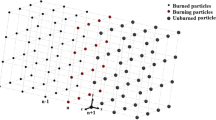Abstract
In this paper, propagation and quenching of aluminum dust flame in narrow channels with infinite length and constant width are investigated. Particles are distributed uniformly in three-dimensional space in a quiescent reaction medium. The combustion of a single particle was first studied, and the solution is presented. Each burning/burned particle is considered as a heat source, and the amount of heat loss to the channel walls is assumed as sink source. Based on the superposition principle, the space–time temperature distribution of particles and the heat loss to the walls are estimated based on the generated code. In this study, the amount of heat loss and quenching distance have been investigated as a function of aluminum dust concentration and particle diameter. The effects of preheating of the walls are also studied on quenching distance and heat loss. The estimated results are compared with the experimental data and show a fairly good agreement. The initial wall temperature affects the heat loss, and with the increase in the wall’s initial temperature, the value of quenching distance will be decreased.








Similar content being viewed by others
Abbreviations
- q′:
-
Rate of heat release
- L :
-
Distance between the layers
- c p :
-
Heat capacity at constant pressure
- T :
-
Temperature
- Q :
-
Total heat released
- x, y, z :
-
The dimensional Cartesian coordinate system
- x′, y′, z′:
-
The non-dimensional Cartesian coordinate system
- B :
-
Mass concentration
- t :
-
Time
- d :
-
Particle diameter
- i, m :
-
The counter
- in :
-
Initial temperature
- ad :
-
Adiabatic temperature
- a :
-
Air
- p :
-
Particle
- w :
-
Wall
- ig :
-
Ignition time
- c :
-
Combustion time
- v :
-
Velocity
- α :
-
Thermal diffusivity
- τ :
-
Non-dimensional time
- ψ, γ :
-
Non-dimensional parameters
- θ :
-
Non-dimensional temperature
- ρ :
-
Particle density
- σ :
-
Variance
- η :
-
Non-dimensional velocity
References
Dreizin EL. Metal-based reactive nano materials. Prog Energy Combust Sci. 2009;35(2):141–67.
Eckhoff R. Dust explosions in the process industries: identification and control of dust hazards. Houston: Gulf Professional Publishing; 2003.
Lin-lin L, Pei-jin L, Guo-qiang H. Ignition and combustion characteristics of compound of magnesium and boron. Therm Anal Calorim. 2015;121:1205–12.
Kuriechan SK, Causes and impacts of accidents in chemical process industries and a study of the consequence analysis software. M.Phil. Thesis, Pondicherry University, 2005.
Goroshin S, Higgins AJ, Kamel M. Powdered metals as fuel for hypersonic ramjets. AIAA paper. 2001; 3919.
Trunov MA, Schoenitz M, Dreizin EL. Ignition of aluminum powders under different experimental conditions. Propellants Explos Pyrotech. 2005;30(1):36–43.
Han DH, Shin JS, Sung HG (2016) A detailed flame structure and burning velocity analysis of aluminum dust cloud combustion using the Eulerian–Lagrangian method. In: Proceedings of the combustion institute.
Huang Y, Risha GA, Yang V, Yetter RA. Effect of particle size on combustion of aluminum particle dust in air. Combust Flame. 2009;156(1):5–13.
Bidabadi M, Poorfar AK, Wang S, Bengt S. A comparative study of different burning time models for the combustion of aluminum dust particles. Appl Therm Eng. 2016;105:474–82.
Ballal DR. Ignition and flame quenching of quiescent dust clouds of solid fuels. Proc R Soc Lond A Math Phys Eng Sci. 1980;369(1739):479–500.
Jarosinski JA. Survey of recent studies on flame extinction. Prog Energy Combust Sci. 1986;12(2):81–116.
Proust CH, Veyssiere B. Fundamental properties of flames propagating in starch dust-air mixtures. Combust Sci Technol. 1988;62(4–6):149–72.
Bidabadi M. An experimental and analytical study of laminar dust flame propagation. Montreal: McGill University; 1996.
Tang FD, Goroshin S, Higgins A, Lee J. Flame propagation and quenching in iron dust clouds. Proc Combust Inst. 2009;32(2):1905–12.
Bidabadi M, Zadsirjan S, Mostafavi SA. Propagation and extinction of dust flames in narrow channels. J Loss Prev Process Ind. 2013;26(1):172–6.
Palecka J, Julien P, Goroshin S, Bergthorson JM, Frost DL, Higgins AJ. Quenching distance of flames in hybrid methane–aluminum mixtures. Proc Combust Inst. 2015;35(2):2463–70.
Varma A, Mukasyan AS, Hwang S. Dynamics of self-propagating reactions in heterogeneous media: experiments and model. Chem Eng Sci. 2001;56(4):1459–66.
Mukasyan AS, Rogachev AS, Mercedes M, Varma A. Microstructural correlations between reaction medium and combustion wave propagation in heterogeneous systems. Chem Eng Sci. 2004;59(22):5099–105.
Incropera FP, Dewitt DP. Fundamentals of heat and mass transfer. 5th ed. New York: Wiley; 2002.
Marino TA. Numerical analysis to study the effects of solid fuel particle characteristics on ignition, burning, and radiative emission. Ann Arbor: ProQuest; 2008.
Marion M, Chauveau C, Gökalp I. Studies on the ignition and burning of levitated aluminum particles. Combust Sci Technol. 1996;115(4–6):369–90.
Yetter RA, Frederick LD. Metal particle combustion and classification. In: Microgravity combustion: fire in free fall. 2001: 419–478
Kim SW. Theoretical and experimental studies on flame propagation and quenching of powdered fuels. Ames: Iowa State University; 1989.
Yunlan S, Rong S, Baozhong Z, Keke M, Yuxin W. Thermal reaction mechanisms of nano- and micro-scale aluminum powders dioxide at low heating rate. Therm Anal Calorim. 2016;124(3):1727–34.
Author information
Authors and Affiliations
Corresponding author
Rights and permissions
About this article
Cite this article
Bidabadi, M., Biouki, S.A., Afzalabadi, A. et al. Modeling propagation and extinction of aluminum dust particles in a reaction medium with spatially uniform distribution of particles. J Therm Anal Calorim 129, 1855–1864 (2017). https://doi.org/10.1007/s10973-017-6338-9
Received:
Accepted:
Published:
Issue Date:
DOI: https://doi.org/10.1007/s10973-017-6338-9



